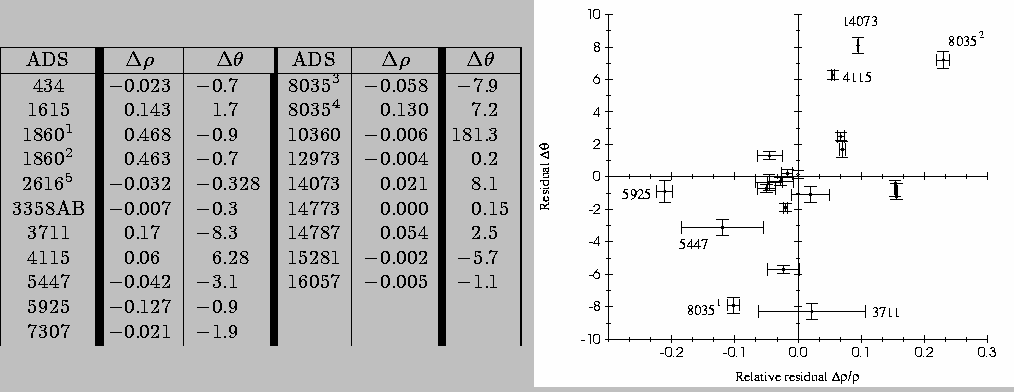

Up: ICCD speckle observations

footnotesize 1: 1st orbit given by Heintz.
2: 2nd orbit given by Heintz.
3: Couteau 1958. 4: Heintz 1956
5: Luyten 1934.
Figure 5: Table on the left gives the residuals in separation ( )
and position angle (
)
and position angle ( ). Figure on the right is a graphics
visualization of the residuals in a
). Figure on the right is a graphics
visualization of the residuals in a  plane. Each measurement corresponds to a point in the graph. Error bars in
plane. Each measurement corresponds to a point in the graph. Error bars in
 and
and  have been drawn to scale. For c Her (ADS 10360) the
residual in
have been drawn to scale. For c Her (ADS 10360) the
residual in  has been taken as 1.3
has been taken as 1.3 for the plot (instead of
181.3
for the plot (instead of
181.3 )
)
The measurements are summarized in Table 2 (click here). Positions are
compared with those computed from the latest available orbits. Orbital
elements are from the catalog of Worley & Heintz (1983)
and the Sky Catalogue 2000 Vol. 2 for orbits prior to
1984. Recent orbital elements were found on the home page of Pr. W. Heintz
(http://laser.swarthmore.edu/html/ research/heintzr.html) and in the
literature (references are given in Col. 2).
This paper presents the first extensive application of speckle techniques
based on the probability density functions of specklegrams. This method
developed at Nice university is well adapted to the data reduction of
binary star speckle data. Relative photometry computed this way (cf
Sect. 3.4) is found to be consistent with direct image reconstruction from
bispectral techniques (cf Sect. 3.5).
The residuals in  and
and  are given in Fig. 5 (click here).
The cloud of points around
are given in Fig. 5 (click here).
The cloud of points around  validates the
data reduction. It can however be noticed that several stars are found far
from the expected position computed from the latest available orbit. Clearly
some published orbits have to be reconsidered. This is the case for ADS 3711
(orbit estimated in 1969, period P=199y), ADS 4115 (1951, P=586y),
ADS 5925 (1966, P=512y) and ADS 8035 (Couteau Orbit: 1958, P=44.7y (Sky
Cat. 2000) - Heintz orbit: 1956, P=44.4y (Worley & Heintz
1983)).
validates the
data reduction. It can however be noticed that several stars are found far
from the expected position computed from the latest available orbit. Clearly
some published orbits have to be reconsidered. This is the case for ADS 3711
(orbit estimated in 1969, period P=199y), ADS 4115 (1951, P=586y),
ADS 5925 (1966, P=512y) and ADS 8035 (Couteau Orbit: 1958, P=44.7y (Sky
Cat. 2000) - Heintz orbit: 1956, P=44.4y (Worley & Heintz
1983)).
The stars ADS 5447 and ADS 14073 are also found far from their expected
position, although the orbits are quite recent (1989 for ADS 14073, 1992 for
ADS 5447). More observations are clearly needed before giving a conclusion.
For the star ADS 2616, we have computed the position from the ephemeris of
Luyten (1934) and Scardia (1985). Surprisingly, we found
that the 1934 orbit does better fit the observed position.
The case of c Her (ADS 10360) is interesting since we found a residual of
181.3 on the position angle resulting from a confusion between
components A and B. This may occur when the magnitude difference is close to
zero: measurements of c Her available at the CHARA catalog (
http://www.chara.gsu.edu/CHARA/chara.html) show sometimes a 180
on the position angle resulting from a confusion between
components A and B. This may occur when the magnitude difference is close to
zero: measurements of c Her available at the CHARA catalog (
http://www.chara.gsu.edu/CHARA/chara.html) show sometimes a 180 uncertainty on
uncertainty on  between successive observations. One could object
that our observation was made in the red domain, but the spectral types of
the two stars are identical (A9 IV) (which should be further investigated),
and the brighter star of the couple is the same whatever the color.
ADS 10360 needs to be observed again in several color bands for confirmation
and to check whether the problem comes from a poor observation or a
difference of spectral type of the two binary components.
between successive observations. One could object
that our observation was made in the red domain, but the spectral types of
the two stars are identical (A9 IV) (which should be further investigated),
and the brighter star of the couple is the same whatever the color.
ADS 10360 needs to be observed again in several color bands for confirmation
and to check whether the problem comes from a poor observation or a
difference of spectral type of the two binary components.
Acknowledgements
The authors whish to thank the technical staff of
the TBL: André Augé, Christian Decha, Pierre Déréthé, Christian
Duthu, Francis Laccassagne, Jean-Marie Lavie-Cambo and Christian Lucuix
(Observatoire Midi-Pyrénées) for help during the observations; Michel
Aurière (Observatoire Midi-Pyrénées) and Institut National des
Sciences de l'Univers for financial support. Thanks are also due to Pr.
Wulff Heintz for helping in using the orbital elements from his database.
This work made use of the SIMBAD astronomical database and of the CHARA 3rd
catalogue of interferometric measurements of binary stars.


Up: ICCD speckle observations
Copyright by the European Southern Observatory (ESO)
web@ed-phys.fr
